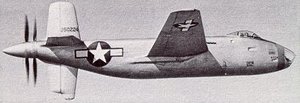XB-42 Mixmaster
|
|
The Douglas XB-42 Mixmaster was an experimental bomber aircraft, designed for a high top speed. The unconventional approach was to mount the two engines within the fuselage driving a pair of contra-rotating propellers mounted at the tail, leaving the wing and fuselage clean and free of aerodynamics-reducing protrusions. Two prototype aircraft were built, but the end of World War II changed priorities, and the advent of the jet engine gave an alternative way toward achieving high speed.
Developed initially as a private venture, an unsolicited proposal was presented to the United States Army Air Force in May 1943. This resulted in an Air Force contract for two prototypes, the Air Force seeing an intriguing possibility of finding a bomber capable of the B-29 Superfortress' range without its size or cost.
The aircraft mounted a pair of Allison V-1710-125 liquid-cooled V-12 engines behind the crew's cabin, each driving one of the twin propellors. Air intakes were in the wing leading edge. The undercarriage was tricycle, and there was a long fin under the tail to prevent the propeller from striking the ground. The pilot and co-pilot sat under twin bubble canopies, and the bombardier sat in the extreme front behind a glass nose. Defensive armament was two 0.50" machine guns in turrets in the trailing edge of the wing, which retracted into the wing when not in use. These guns could only cover the rearward direction, but with the plane's high speed it was thought unlikely that intercepting fighters would be attacking from any other angle.
The first XB-42 prototype flew on May 6, 1944. Performance was excellent, being basically as described in the original proposal; as fast or faster than the De Havilland Mosquito but with twice the bombload and defensive armament. The twin bubble canopies proved a bad idea, and the aircraft suffered from some instability, vibrations and poor engine cooling - all problems that could probably have been dealt with.
The end of World War II, though, allowed the Air Force to consider possibilities in a little more leisure, and it was decided to wait for the development of better jet bombers rather than continue with the B-42 program.
One of the XB-42 aircraft had been destroyed in a crash, but the other was used in flight test programs, including fitting uprated engines and underwing turbojets, making it the XB-42A. In this configuration, it reached 488 mph (785 km/h). Damaged in a hard landing in 1947 after 22 flights, it was repaired but never flew again.
The prototype was struck off charge in 1949 and was given to the National Air and Space Museum, in whose care it remains although it has never been placed on display.
Specifications (XB-42)
General characteristics
- Crew:
- Length: 53 ft 8 in (16.4 m)
- Wingspan: 70 ft 6 in (21.5 m)
- Height: 18 ft 10 in (5.7 m)
- Wing area: 555 ft² (51.6 m²)
- Empty: 20,888 lb (9,475 kg)
- Loaded: 33,200 lb (15,060 kg)
- Maximum takeoff: 35,702 lb (16,194 kg)
- Powerplant: 2× Allison V-1710-125 inline engines; 1,800 hp (1,300 kW) each
Performance
- Maximum speed: 410 mph (660 km/h)
- Combat range: 1,800 miles (2,900 km)
- Ferry range: 5,400 miles (8,700 km)
- Service ceiling: 29,400 ft (8,960 m)
- Rate of climb: ft/min ( m/min)
- Wing loading: 59.8 lb/ft² (292 kg/m²)
- Power/mass: 0.11 hp/lb (0.18 kW/kg)
Armament
- 4× .50-caliber (12.7 mm) machine guns
- 8,000 lb (3,600 kg) of bombs
External links
- USAF Museum: XB-42 (http://www.wpafb.af.mil/museum/research/bombers/b4/b4-2.htm) and XB-42A (http://www.wpafb.af.mil/museum/research/bombers/b4/b4-3.htm).
Related content
Related development: XB-43 Jetmaster
Designation sequence: XB-39 - YB-40 - XB-41 - XB-42 - XB-43 - XB-44 - B-45
Related lists: List of military aircraft of the United States - List of bomber aircraft
|
Lists of Aircraft | Aircraft manufacturers | Aircraft engines | Aircraft engine manufacturers Airports | Airlines | Air forces | Aircraft weapons | Missiles | Timeline of aviation |

